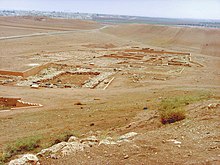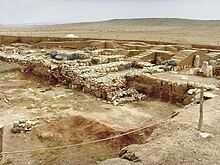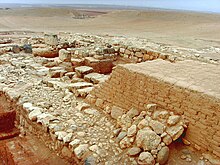Ebla
Ebla was an ancient city in northern Syria , about 55 km southwest of Aleppo . During two periods, towards the end of the 3rd millennium BC, it had BC and between 1800 and 1650 BC BC, the status of a city-state . The settlement mound of the excavation site, which is mainly used for its archive of over 20,000 cuneiform - clay tablets from the 3rd millennium BC. Known is Tell Mardikh .
Discovery and excavation
In 1964, Italian archaeologists from the University of Rome , led by Paolo Matthiae, began excavations at Tell Mardikh . In 1968 they found a statue of the goddess Ištar who was named after a king of Ebla - Ibbit-Lim . This identified the city, which had long been known through Egyptian and Akkadian writings. In the following decade, the team discovered a palace, the Palace of Ebla , which dates back to between 2500 and 2000 BC. Was dated. In the ruins were found the above 20,000 well-preserved cuneiform tablets in Sumerian and Eblaite - a previously unknown Semitic language . These tablets indicate the city's close relationship with southern Mesopotamia, where cuneiform writing was developed. The tables also contained vocabulary lists that made their translation possible.
The translations showed that it was not the palace library - which may still be waiting to be discovered - that they had found here, but an archive of taxes and duties, legal texts, diplomatic and commercial contacts, and a writing room in which texts were copied. The larger panels were originally placed on shelves from which they fell out when the palace was destroyed. The sites where the tablets were found enabled the excavators to reconstruct their former position. It quickly became apparent that they must have been sorted on the shelves according to their content.
Ebla in the 3rd millennium BC Chr.
The name Ebla means "white rock" and goes back to the limestone rocks on which the city was built. The area showed traces of settlement as early as the 4th millennium BC. BC, but the height of the city's importance was only reached in the second half of the next millennium. Eblas first bloom is between 2400 and 2240 BC. His name is found in Akkadian texts around 2300 BC. Mentioned.
Most of the cuneiform tablets found dating from this period contain economic data. They give a good impression of the daily life of the city dwellers and the cultural, economic and political situation in northern Syria and in the Middle East around the middle of the 3rd millennium BC. They mention places and peoples that are later mentioned in the Old Testament , including the first mention of Jerusalem . Over 80 city-states appear in these texts (e.g. Ebal , Manuwat , Binasu ).
economy
In its heyday, Ebla was an important economic center thanks to its strategic location on the trade routes between the Euphrates and the Mediterranean . The panels show that the residents of Eblas owned over 200,000 animals (sheep, goats and cows). The city's most important trading goods were probably wood from the nearby mountains, possibly also from Lebanon , and textiles, which are mentioned in Sumerian texts from the city-state of Lagaš . The main trading partner was probably Mesopotamia , especially Kiš , and contacts with Egypt through gifts from the Pharaohs Chephren and Pepi I are known. The Egyptians were also the main consumers of from Afghanistan coming lapis lazuli . Handicrafts may also have been an important export: exquisite items were recovered from the ruins, such as ebony furniture with mother-of-pearl inlays and statues made from stones of different colors. Ebla's art style may have dated from 2350 to 2150 BC. Influenced subsequent Akkadian Empire.
Politics and administration
The political organization is rather unclear, but the city appears to have been ruled by a merchant aristocracy who chose a king and assigned the defense of the city to hired mercenaries. The names of kings were handed down through the cuneiform tablets :
The monarchy may have become hereditary after the Ebrian as his sons are said to have ruled nearby places.
religion
At that time, some known ( Dagān , Ištar , Reschef , Kanisch , Hadad ) and some unknown ( Kura , Nidakul ) Semitic deities were worshiped in Ebla , as well as some Sumerian ( Enki , Ninki ) and Hurrian gods ( Aštabi , Ḫepat , Išḫara ). The main gods of Ebla were Kura, Utu and Adda (NI-dabbal). Giovanni Pettinato assumes that Dagan ( d BE) was the main god of Ebla, possibly even a supreme god ( Henotheism ), but here few other researchers followed him. According to Feliu, d BE cannot be identified with certainty with Dagan.
The destruction of Ebla
Sargon of Akkad and his grandson Naram-Sin , the conquerors of large parts of Mesopotamia, both claim to have destroyed Ebla; the exact date of the destruction is disputed, 2240 BC. Chr. Is a possible candidate. For the next three centuries, Ebla remained a small settlement under the control of the nearby town of Urschu .
Ebla in the 2nd millennium BC Chr.
A few centuries after its destruction by the Akkadians, Ebla regained part of its importance and experienced a second heyday from around 1850 to 1600 BC. Its inhabitants were called the Amurrites , whose first king was Ibbit-Lim . Ebla is mentioned in texts from Alalach from around 1750 BC. Mentioned. The city was founded by the Hittite king Muršili I or Ḫattušili I in the turbulent period from 1650 to 1600 BC. Chr. Destroyed.
Ebla never recovered from this second destruction, but was demonstrably continuously inhabited until the Hellenistic period (Ebla VI B goes back to the 1st century BC). Part of the hill was built over by a Byzantine monastery that existed until the 7th century. After that, the place remained deserted.
Destruction in the 21st century
Since 2014, Ebla has been further destroyed by robbery excavations, which apparently served to finance IS by smuggling antiquities. A destroyed archive room with thousands of tablets was exhibited in a reconstructed form in 2016 in the Colosseum in Rome. There was also destruction during the recapture of the IS-occupied areas in Idlib by the Syrian Arab Army (SAA) in February 2020.
literature
- Chaim Bermant, Michael Weitzman: Ebla: Newly discovered civilization in the ancient Orient. Umschau, Frankfurt am Main 1979, ISBN 3-524-69014-9 .
- Afif Bahnassi: Ebla Archives 1993, 2nd edition.
- Paolo Matthiae: Ebla. Rediscovered to Empire. Hodder and Stoughton, London 1980, ISBN 0-340-22974-8 .
- Georg Gerster : Shards make history. In: Geo-Magazin. Hamburg 1980, 8, pp. 40-56. Informative experience report on the excavations at Ebla in Syria. ISSN 0342-8311
- Paolo Matthiae: Studies on the Archeology of Ebla. 1980-2010. Harrassowitz, Wiesbaden 2013, ISBN 978-3-447-06937-3 .
- Paolo Matthiae, Nicoló Marchetti (Eds.): Ebla and Its Landscape. Early State Formation in the Ancient Near East , Routledge, 2013.
Individual evidence
- ↑ Lluís Feliu: The God Dagan in Bronze Age Syria (= Culture and History of the ancient Near East Vol. 19). Brill, Leiden et al. 2003, ISBN 90-04-13158-2 (also: Barcelona, University, dissertation, 2000).
- ↑ Susan Wolfi Barger et al .: Ancient History, Modern Destruction: Assessing the status of Syria's Tentative World Heritage Sites Using High-Resolution Satellite Imagery. AAAS , 2014, accessed August 3, 2017 .
- ↑ Roma: al Colosseo rivivono Ebla, Nimrud, Palmira. il Velino, October 5, 2016, accessed August 3, 2017 (Italian).
- ↑ AnnaTV (Russian), drone recordings, accessed on February 9, 2020
Web links
- Ebla Digital Archives
- Lucio Milano: Ebla: A Third-Millennium City-State in Ancient Syria. In: Jack M. Sasson (Ed.): Civilizations of the Ancient Near East. Volume 2. Charles Scribner's Sons et al., New York NY 1995, ISBN 0-684-19721-9 , pp. 1219-1231, (PDF; 1.1 MB).



